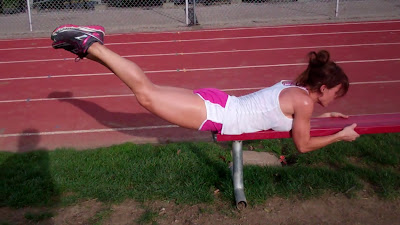You've been training. You know what your body is capable of and you line up to start the race, pumped and ready to go. You've got this!
Sometimes something crazy happens between the Start and the Finish Line. Things don't go as planned. You don't run as fast as you know you can, or as fast as you were practicing. What the Heck???
Recently I had my first bad 5K experience. I raced my slowest 5K ever (even slower than the first 5K I ever did!) I was not a happy camper when I crossed that finish line. I felt like it was one of the hardest races I had ever run, and I didn't have the finish time to show for it.
Having had time to reflect, there were a few things I did wrong that were controllable, and a few things that were outside of my control.
Here are some things that might be throwing off your race pace.
1. Listening to Music During the Race:
This was my first 5K listening to music.
Why is this on my list of things I did wrong?
It changed my pacing and decreased my awareness of how hard my body was working. I have a GPS Running watch, and when I uploaded the workout my pacing was all over the place. I was fluctuating my pace up to 2:30 difference during each mile of the run. I basically turned the run into an interval workout. The music was loud enough that I couldn't hear my breathing, and it was harder to gauge my effort.
2. Paying to Much Attention to Your Watch:
Every time I looked at my watch I was going "to fast." As a result I kept slowing down. My watch was telling me my "right now" time, not average pace. This contributed to my interval-style race, which exhausted me much more than pacing at a continuous effort that I could maintain.
I have my watch set to tell me my mile pace, so even though I was going "to fast" every time I glanced at my watch, when I saw my average at each mile it was slower than my goal. Which led to me speeding up again.
3. Weather:
This one is outside of your control, but it does affect your race pace. The hotter the race the more you will be affected.
Ideal running temperature is 50 degrees. At this temp your race pace will not be changed.
Example for an 8 min/mile runner:
50 degrees: Average Pace 8 min/mile. 0% change.
60 degrees: Pace Increases to 8:12 min/mile. 2-3% change.
70 degrees: 8:31 min/mile. 6-7% change.
80 degrees: 9:06 min/mile. 12-15% change.
85 degrees: 9:30 min/mile. 18-20% change.
The race was hot, sunny and humid. Whenever I got a little bit of shade it felt heavenly. I didn't want to drink any water, but I wanted to dump a cup on myself to cool off. However, when I ran by the water station they had already handed off all their cups, and I didn't want to stop and wait for one.
4. Running Tired:
My glutes were sore from some of my Bender Fitness workouts. I rarely ever get sore from working out because my body has adjured to the types of challenges I give it. I also put in some great runs the week of the race.
For the best race results you want to taper your training 1-2 weeks before your race so your body is fresh and ready to put in a great effort. You allow your body to recover from the fatigue of all your hard work, and you will be ready to run a great race.
The good news about running a bad 5K? They have them every weekend! So you can always redeem yourself at your next race (after a proper recovery!)
I wanted to practice my pacing for my next race so I hopped on the treadmill and did a 5K. I selected a challenging, but sustainable pace. It was a pace where I knew I could go harder/faster.
The result? 22:46 minute 5K. Compared to the 24:40 I raced a few days earlier I felt redeemed. My fitness hadn't suffered. It was just a bad race day. Whatever your running goals are. Don't let one bad day undermine all of your hard work. Keep training, and keep showing up. Your consistency pays off.
In case you were wondering how Jesse did...
He came home with another medal. He wasn't done running there. He ran another 5 miles immediately after the race. I listened to my body, recovered, and took advantage of the free massage offered at the end of the race.















.jpg)















